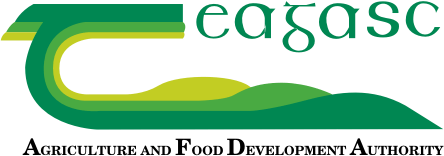26 April 2021
Major Focus on Clover establishment and Management in 2021
A clover booklet ‘Management and establishment of grass-white clover swards’ for 2021 is being launched by Teagasc today, Monday, 26 April. Agriculture in Ireland is under ever increasing pressure to reduce nitrogen fertiliser use, reduce greenhouse gas emissions and increase nitrogen use efficiency.
White clover has a very important role to play in sustainable Irish pasture-based milk and meat production systems. The high quality forage and the nitrogen fixation benefits of grass-white clover pastures have led to a resurgence of interest in its use as a means of reducing the economic and environmental costs in pasture-based milk and meat production systems. Additionally, the EU Farm to Fork strategy (2030) has increased the urgency to focus research on the role of white clover to reduce chemical nitrogen fertiliser use.
Dr. Michael O’Donovan, Head of Grassland Research at Teagasc, said that ‘farmers must put a plan in place to begin establishing white clover on their farms so that animal production benefits can be achieved and nitrogen fertiliser use can be reduced. Between now (late-April) and mid-June is the optimum time for establishing white clover in grassland swards through either over-sowing, or reseeding.’
This booklet provides farmers with information on establishment of grass-white clover swards and the management to ensure those swards are productive and persistent. Clover can add more to Ireland’s successful grassland efficiency, but it needs better management, especially in the first year post sowing.
Research is currently being undertaken at Teagasc Moorepark, Curtins, Clonakilty and Athenry research farms on the role of white clover in our production systems. The research programme to date has delivered very promising results. It has demonstrated higher animal performance, reduced requirement for nitrogen fertiliser, high nitrogen use efficiency of close to 60% and lower nitrogen surplus.
Dr. Deirdre Hennessy, Teagasc researcher and an author of the booklet, said that ‘with clover we have shown very high nitrogen use efficiency in our work, with the added bonus of higher animal performance’. This technical booklet provides clear guidelines on the management and establishment of grass-white clover swards for sheep, cattle and dairy cows so that the benefits seen on the research farms can be achieved at farm level.
There is a clear challenge to ensure that grass-white clover swards are established and persist on Irish grassland farms. To address this challenge, the booklet also coincides with a new on-farm clover project led by Dr. Michael Egan, Teagasc researcher. The objective of the on-farm programme is to establish a number of clover pilot farms across the country. These will provide the opportunity for other farmers to learn from the pilot farms experiences, and provide confidence to the grassland industry in establishing and managing grass-white clover swards. Dr. Egan said; ‘We have established a network of 30 beef, sheep and dairy farms across the country who are committed to establishing and managing clover on their farms. This in the longer term will provide great information back to the industry. Some of these farms have had very good clover establishment over the past number of years, and we hope to build on this’.
The booklet is authored by Teagasc researchers working in the area of grass-white clover and is available here: https://www.teagasc.ie/publications/2021/management-and-establishment-of-grass-white-clover-swards.php .
